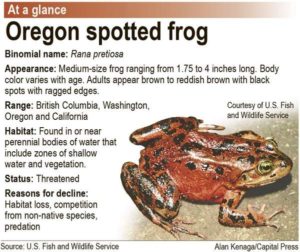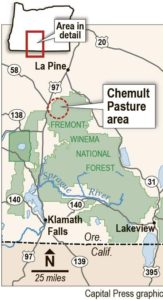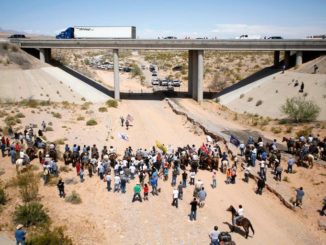Grazing halted to study impacts on Oregon spotted frog
A federal judge has prohibited cattle grazing on 68,000 acres in Oregon’s Fremont-Winema National Forest until federal officials reconsider its impacts on Oregon spotted frogs.
Annual grazing authorizations for the Chemult Pasture issued by the U.S. Forest Service “did not account for evidence in the record showing cattle trespass, unauthorized use, and harm to habitat under the current management,” according to U.S. District Judge Ann Aiken.
Further grazing authorizations should be enjoined until the agency can determine the actual effects of grazing on the viability of spotted frogs and other sensitive species, according to Aiken’s ruling, which upholds conclusions reached by U.S. Magistrate Judge Mark Clarke.
 Multiple environmental groups — Concerned Friends of the Winema, Klamath-Siskiyou Wildlands Center, Western Watersheds Project, Oregon Wild and the Center for Biological Diversity — have long opposed grazing within the pasture, which has been ranched by the Iverson family for more than a century.
Multiple environmental groups — Concerned Friends of the Winema, Klamath-Siskiyou Wildlands Center, Western Watersheds Project, Oregon Wild and the Center for Biological Diversity — have long opposed grazing within the pasture, which has been ranched by the Iverson family for more than a century.
A lawsuit filed in 2008 was dismissed as moot because the U.S. Forest Service had built a riparian fence within the pasture to protect the frogs, which are now a threatened species.
In another case, filed in 2010, the Forest Service was found to have violated environmental laws but the judge didn’t impose an injunction against grazing because it would have been impractical and likely hurt frog populations on private land elsewhere.
The most recent complaint accuses the agency of underestimating the damage that cattle inflict on wetland habitats inhabited by spotted frogs in violation of several environmental laws.
 The plaintiffs argued that during dry periods, the frogs gather in shallow pools and are trampled by cattle that regularly venture beyond areas they’re authorized to graze.
The plaintiffs argued that during dry periods, the frogs gather in shallow pools and are trampled by cattle that regularly venture beyond areas they’re authorized to graze.
Because such unauthorized grazing wasn’t fully analyzed by the Forest Service, the agency’s conclusion that cattle had only a minimal impact on the species “lacks rational support” contrary to the National Forest Management Act, according to the court.
The court characterized as “scientifically baseless” the Forest Service’s estimate that only 3 percent of spotted frogs were trampled by cattle, which is unlawfully “arbitrary and capricious” under the Endangered Species Act.
The extent of non-lethal harassment and harm to the species — which is also prohibited by ESA — was also left out of the agency’s analysis, the court held.
“Federal defendants offer little reasoning why they do not to include these measures of take of individual (Oregon spotted frogs), beyond alluding to practical difficulties in finding and measuring bodies of dead or injured (Oregon spotted frogs),” the ruling said.





Havn’t we heard this crock before ? So these frogs are just going to sit there and let themselves be stepped on ? Try sneaking up on one and see how close you get before it’s gone. But no,as Lavoy has said,the problem is that these “Swarms of agents sent out to harass us and eat out our substance” are there at all.